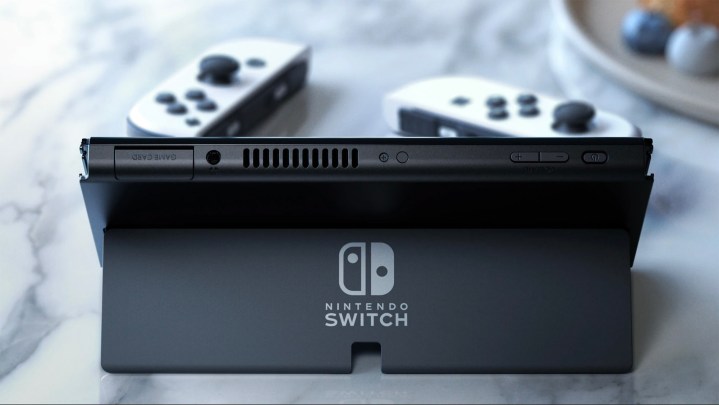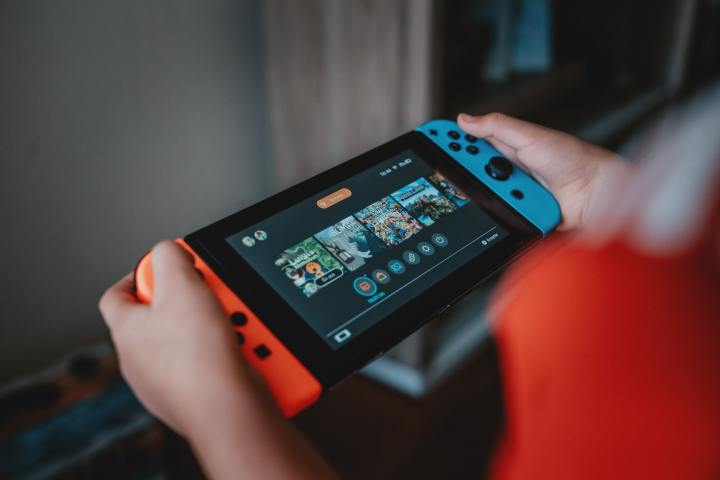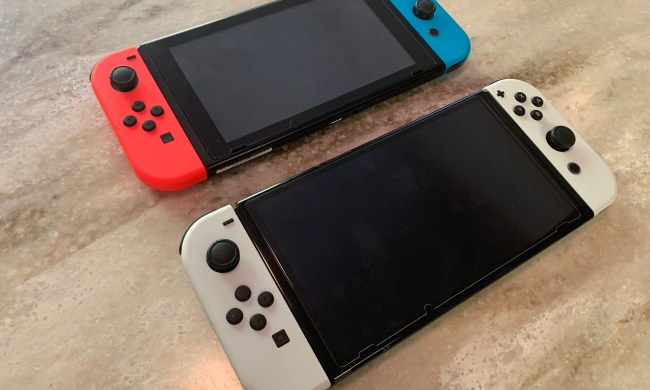The Nintendo Switch OLED serves as yet another iteration of the handheld hybrid, boasting an improved screen and a boatload of bells and whistles. At first glance, the OLED model might not appear too different from the original Switch, but it certainly has a variety of new features you should be aware of, especially if you’re thinking of upgrading. Given the original Switch is nearly five years old at this point, it’s a great time to grab an OLED. Or perhaps you’re considering purchasing a Switch for the first time.
Either way, it’s good to know the difference between the original and the OLED, so you can make an informed purchase — and that’s where we come in. Here, we’ll compare the original Switch to the new OLED model, with details that will hopefully help you choose one over the other.
Recommended reading:
- 8 problems the Nintendo Switch OLED model doesn’t fix
- Switch OLED vs. Switch Lite
- The best Nintendo Switch games for 2021
Specs
| Nintendo Switch | Nintendo Switch OLED | |
| Size | Approximately 4 inches high, 9.4 inches long, and .55 inches deep (with Joy-Con attached) | 4 inches high, 9.5 inches long, and .55 inches deep (with Joy-Con attached) |
| Weight | .66 pounds (.88 pounds with Joy-Con controllers attached) | Approximately .71 pounds (.93 pounds with Joy-Con controllers attached) |
| Screen | Multi-touch capacitive touch screen / 6.2-inch LCD Screen / 1280 x 720 | Multi-touch capacitive touch screen / 7.0-inch OLED screen / 1280×720 |
| CPU/GPU | NVIDIA Custom Tegra processor | NVIDIA Custom Tegra processor |
| Storage | 32 GB of internal storage (microSD card expandable) | 64 GB (microSD card expandable) |
| Wireless | Wi-Fi (IEEE 802.11 a/b/g/n/ac) | Wi-Fi (IEEE 802.11 a/b/g/n/ac compliant) |
| Video output | Up to 1080p via HDMI in TV mode and up to 720p via built-in screen in tabletop mode and handheld mode | Up to 1080p via HDMI in TV mode / Up to 720p via built-in screen in Tabletop mode and Handheld modes |
| Audio output | Compatible with 5.1ch Linear PCM output with output via HDMI | Compatible with 5.1ch Linear PCM output / Output via HDMI connector in TV mode |
| Speakers | Stereo | Stereo |
| Buttons | Power button / Volume button | Power button / Volume button |
| USB connector | USB Type-C | USB Type-C |
| Headphone/mic jack | 3.5mm 4-pole stereo (CTIA standard) | 3.5mm 4-pole stereo (CTIA standard) |
| Game card slot | Nintendo Switch game cards | Nintendo Switch game cards |
| microSD card slot | Compatible with microSD, microSDHC, and microSDXC memory cards | Compatible with microSD, microSDHC, and microSDXC memory cards |
| Sensor | Accelerometer, gyroscope, and brightness sensor | Accelerometer, gyroscope, and brightness sensor |
| Operating environment | 41-95 degrees / 20%-80% humidity | 41-95 degrees / 20%-80% humidity |
| Internal battery | Lithium-ion battery/4310mAh | Lithium-ion battery / 4310mAh |
| Battery life | Approximately 4.5 to 9 hours | Approximately 4.5 to 9 hours |
| Charging time | Approximately 3 hours | Approximately 3 hours |
| DT review | 4/5 stars | 4/5 stars |
| Availability | Available now | Available now |
Design and features

The Switch and the Switch OLED have a lot in common, from their design to their features. However, there are some distinct differences you should be aware of, as each system is targeted at slightly different audiences. The most important factor to consider is the OLED’s screen, which makes colors stand out more and is noticeably larger than the one on the original model. As its name suggests, it boasts a 7.0-inch OLED screen, as opposed to the 6.2-inch LCD screen on the original. Aside from being larger, the OLED screen is unique in that it provides a backlight to illuminate pixels even further. What this means is that colors will appear more vibrantly, making the original screen seem dimmer by comparison. To players who plan on playing in handheld mode more, the OLED should be your first choice.
You’ll also gain access to a built-in LAN port within the OLED’s dock, which makes it much more convenient to connect an Ethernet cable to it. By default, all Nintendo Switch consoles support Wi-Fi, but connecting via an
One of the downsides of the original Switch is its flimsy, thin kickstand. It works well enough, but it always feels like the Switch is going to collapse under the weight of the kickstand. Now, thanks to the Switch OLED’s new and improved kickstand, you’ll have fewer issues. This is because the kickstand covers the entire backside of the Switch OLED, is significantly sturdier, and allows for multiple degrees of positioning. In short, the new kickstand on the Switch OLED is better in nearly every way.
Finally, the Switch OLED features white Joy-Con controllers, which marks the first time they’ve been made available in that color (at least officially). Plus, the Switch OLED comes with a built-in screen protector, which was a nice surprise. Ultimately, the Switch OLED has a slew of additional features that stand out above the original model. Aside from that, the OLED does not have any CPU or processing improvements from the original.
Controllers

When it comes to controller support, the Switch and the Switch OLED are practically identical. You can connect any Joy-Con to either system, along with the Pro Controller, and even third-party USB wired gamepads. Wired controllers must be connected to the dock, meaning you can only use them in TV mode. The Switch OLED’s dock features two USB ports on the exterior, while the original Switch dock has three — one on the inside, and two on the exterior. This is a slight win for the original Switch, as it has more USB ports.
Both systems can connect wirelessly to additional controllers in handheld, docked, or TV mode. We highly suggest playing with a Pro Controller, as it feels just like a traditional gamepad you’d find on a PS5 or Xbox Series X/S. It works well, especially with games that require accuracy such as shooters. Both systems come with two Joy-Con controllers out of the box. Each Joy-Con can be flipped horizontally and used as an individual controller, meaning two players can enjoy the system right away.
Games

Once again, both systems support the same exact games. You can buy physical cartridges or digital downloads via the eShop. One thing to note is that the Switch OLED features 64GB of onboard memory, while the original only has 32GB. You can expand the memory using microSD cards, but by default, the Switch OLED has more memory. It’s worth noting, too, that if you connect the Switch OLED via
Aside from that, games will look better on the OLED in handheld mode, thanks to the enhanced screen. But if you only plan on playing docked, you won’t reap the benefits of the enhanced screen, so in that case, you can get away with using the original Switch instead.
Price

The Switch OLED touts a fantastic array of features, but they come at an additional cost. You can pick up an original Switch model for $300, and in some cases, even less. By contrast, the Switch OLED is $350, but it comes with a slew of added bonuses such as the larger OLED screen, the built-in LAN port, a better kickstand, and white Joy-Con controllers. It’s possible the original Switch will receive a price cut sometime soon, but as it stands, it has stayed at around $300 since 2017 and hasn’t fluctuated since. Ultimately, you can be the judge of whether that extra $50 is worth the price of admission for the Switch OLED.
Conclusion
While the Switch OLED is superior to the original model in more ways than one, it doesn’t necessarily mean it’s the best option for you. The Switch OLED is perfect for those who want to play in handheld mode often, as it boasts a bigger, better screen. It’s also ideal for those who want to play online frequently or download most of their games since the system features a built-in LAN port on the dock. Or maybe, you just love the white Joy-Con controllers it comes with.
If you already own a regular Switch system, it’s tough to recommend upgrading since the original model gets the job done just fine. If you don’t have a Switch already and are considering getting one, the OLED is likely the better option. Even if its new features aren’t necessarily appealing to you, it’s nice having the newest model. Though it’s worth mentioning, the OLEDs have been hard to come by, meaning you’ll likely have no choice but to get the original model, at least for the time being. Players who simply want to enjoy some of the best Nintendo games but aren’t particular about how they look should consider purchasing the original Switch model, as it’s less expensive, more readily available, and works just fine.
After spending some time with the Switch OLED, it’ll be hard to go back to the original model, especially in handheld mode. As we said in our Switch OLED review: “The Nintendo Switch OLED may not be what players dreamed of, but it’s undeniably a technical step up for the Switch.” With that in mind, hopefully you can confidently make a decision that suits your needs.



